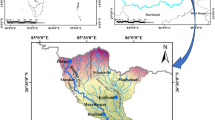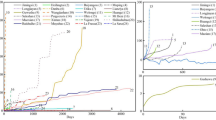Abstract
This paper introduces a new technique in the automatic detection of storm sudden commencement (SC) using the discrete wavelet transform (DWT). A geomagnetic storm is a global simultaneous phenomenon affecting the whole Earth, which means that all ground magnetometers running online will record this event. An algorithm using different characteristic features of the SC is proposed. The selection of an optimal threshold for feature parameters is critical for the success of SC automatic detection. Therefore, this paper uses particle swarm optimization (PSO) to determine the optimal feature threshold values. The developed algorithm is based on data records from a network of ground magnetometers. This algorithm is implemented via multi-resolution analysis (MRA) of the DWT using the Haar wavelet filter. Four-year data sampled at one sample/s from six ground stations from low to high latitudes were analyzed to develop and test this technique. Data representing 450 days from five stations operating simultaneously are available. The confusion matrix of all possible outcomes shows that the accuracy of the proposed algorithm is 97.33%.





Similar content being viewed by others
References
Shinohara, M.; Kikuchi, T.; Nozaki, K.: Automatic realtime detection of sudden commencement of geomagnetic storms. J. National Inst. Inf. Commun. Technol. 52(3/4) (2005)
Chapman, S.: On the times of sudden commencement of magnetic storms. Proc. Phys. Soc. London 30(1), 205 (1917)
Araki, T.: A physical model of the geomagnetic sudden commencement. Geophys. Monograph Am. Geophys. Union 81, 183–183 (1994)
Moos, N.A.F.: Magnetic Observations Made at the Govt. Observatory, Bombay, for the Period 1846–1905 and Their Discussion, Part II. (1910)
Takano, S.; Minamoto, T.; Arimura, H.; Niijima, K.; Iyemori, T.; Araki, T.: Automatic detection of geomagnetic sudden commencement using lifting wavelet filters. pp. 242–251 (1999)
Mendes Jr., O.; Domingues, M.O.; Da Costa, A.M.; De Gonzalez, A.L.C.: Wavelet analysis applied to magnetograms: singularity detections related to geomagnetic storms. J. Atmos. Solar Terr. Phys. 67(17–18), 1827–1836 (2005)
Khabarova, O.; Pilipenko, V.; Engebretson, M. J.; Rudenchik, E.: Solar wind and interplanetary magnetic field features before magnetic storm onset, Vol. 8, pp. 1–6 (2006)
Hafez, A.G.; Ghamry, E.: Automatic detection of geomagnetic sudden commencement via time–frequency clusters. Adv. Space Res. 48(9), 1537–1544 (2011)
Hafez, A.G.; Ghamry, E.; Yayama, H.; Yumoto, K.: Un-decimated discrete wavelet transform based algorithm for extraction of geomagnetic storm sudden commencement onset of high resolution records. Comput. Geosci. 51, 143–152 (2013)
Segarra, A.; Curto, J.: Automatic detection of sudden commencements using neural networks. Earth Planets Space 65(7), 791–797 (2013)
Bailey, R.L.; Leonhardt, R.: Automated detection of geomagnetic storms with heightened risk of GIC. Earth Planets Space 68(1), 1–13 (2016)
Al-Jarrah, M.A.; Yaseen, M.A.; Al-Dweik, A.; Dobre, O.A.; Alsusa, E.: Decision fusion for IoT-based wireless sensor networks. IEEE Internet Things J. 7(2), 1313–1326 (2019)
Al-Jarrah, M.A.; Al-Dweik, A.; Ikki, S.S.; Alsusa, E.: Spectrum-occupancy aware cooperative spectrum sensing using adaptive detection. IEEE Syst. J. (2019)
Liu, S.; Wang, K.; Liu, K.; Chen, W.: Noncoherent decision fusion over fading hybrid MACs in Wireless Sensor Networks. Sensors 19(1), 120 (2019)
Yumoto, K.: MAGDAS project and its application for space weather. ilws: p. 399 (2006)
Curto, J.; Araki, T.; Alberca, L.: Evolution of the concept of sudden storm commencements and their operative identification. Earth Planets Space 59(11), 1–12 (2007)
Tsunomura, S.: Characteristics of geomagnetic sudden commencement observed in middle and low latitudes. Earth Planets Space 50(9), 755–772 (1998)
Takeuchi, T.; Araki, T.; Viljanen, A.; Watermann, J.: Geomagnetic negative sudden impulses: interplanetary causes and polarization distribution. J. Geophys. Res. Space Phys. 107(A7), SMP-7 (2002)
Chapman, S.: An outline of a theory of magnetic storms. Proc. R. Soc. Lond. Ser. Contain. Papers Math. Phys. Character 95(666), 61–83 (1918)
Percival, D.B.; Walden, A.T.: Wavelet methods for time series analysis, vol. 4. Cambridge University Press, Cambridge (2000)
Jach, A.; Kokoszka, P.; Sojka, J.; Zhu, L.: Wavelet-based index of magnetic storm activity. J. Geophys. Res. Space Phys. 111, A09215 (2006). https://doi.org/10.1029/2006JA011635
Hafez, A.G.; Ghamry, E.; Yayama, H.; Yumoto, K.: Systematic examination of the geomagnetic storm sudden commencement using multi resolution analysis. Adv. Space Res. 51(1), 39–49 (2013)
Shi, Y.; Eberhart, R.C.: Fuzzy adaptive particle swarm optimization. In: Proceedings of the 2001 congress on evolutionary computation (IEEE Cat. No. 01TH8546). (2001)
Blondin, J.: Particle swarm optimization: A tutorial. from site: http://cs.armstrong.edu/saad/csci8100/psotutorial.pdf (2009)
Santra, A.; Christy, C.J.: Genetic algorithm and confusion matrix for document clustering. Int. J. Comput. Sci. Issues (IJCSI) 9(1), 322 (2012)
Author information
Authors and Affiliations
Corresponding author
Rights and permissions
About this article
Cite this article
Elgiddawy, S.A., Hafez, A.G., Lethy, A. et al. The Multi-Optimized Parameter Technique for Near Online Automatic Determination of Geomagnetic Sudden Commencement Arrival Time. Arab J Sci Eng 46, 901–908 (2021). https://doi.org/10.1007/s13369-020-04773-3
Received:
Accepted:
Published:
Issue Date:
DOI: https://doi.org/10.1007/s13369-020-04773-3




